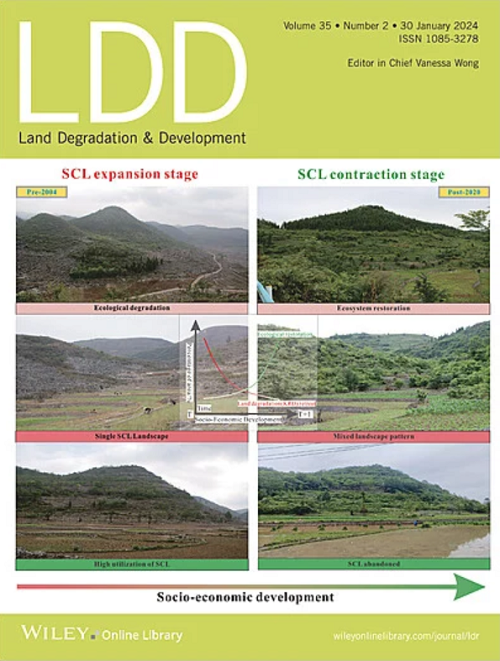高原鼠兔(Ochotona curzoniae)干扰改变了青藏高原高寒草甸土壤微生物酶C-N-P化学计量,并推动了N -限制向P -限制的转变
IF 3.6
2区 农林科学
Q2 ENVIRONMENTAL SCIENCES
引用次数: 0
摘要
土壤-微生物-酶C-N-P化学计量学是养分循环和生态系统恢复力的重要指标。研究了青藏高原高寒草甸鼠兔对高原鼠兔干扰的响应。结果表明:高原鼠兔干扰显著提高了土壤有机碳(SOC) 28.97%、土壤全氮(STN) 8.25%、土壤全磷(STP) 9.15%;微生物生物量C (MBC)和N (MBN)分别提高了5.60%和6.30%。β - 1,4 -葡萄糖苷酶(BG)、N -乙酰- β - D -葡萄糖苷酶(NAG)和亮氨酸氨基肽酶(LAP)的酶活性在受干扰的试验区也高于未受干扰的试验区。土壤C:N、C:P和酶N:P比值分别提高19.62%、19.65%和4.48%,MBN: MBP比值降低21.63%。高原鼠兔干扰下,土壤C:N失衡加剧,C:P稳态趋于弱稳态(H′= 2.38)。此外,STP和地下生物量是未受干扰样地土壤酶C:N:P化学计量的关键因子,而有机碳是受干扰样地微生物C:N:P化学计量的最强因子。这些结果表明,高原鼠兔干扰导致微生物代谢策略向利用碳的方向转变,并随着干扰强度的增加逐步将高寒草甸土壤从氮限制转变为磷限制。因此,本研究建议在低干扰强度下定向补氮,而在高干扰强度下施用磷肥以缓解养分限制。本文章由计算机程序翻译,如有差异,请以英文原文为准。
Plateau Pika (Ochotona curzoniae) Disturbance Alters Soil‐Microbe‐Enzyme C–N–P Stoichiometry and Drives a Shift From N‐ to P‐Limitation in Alpine Meadows on the Qinghai‐Tibet Plateau
Soil‐microbe‐enzyme C–N–P stoichiometry is a key indicator of nutrient cycling and ecosystem resilience. This study examines its response to plateau pika (Ochotona curzoniae H ′ = 2.38) under plateau pika disturbance. Moreover, STP and underground biomass were identified as key factors regulating soil‐enzyme C–N–P stoichiometry in undisturbed plots, while SOC was the strongest factor associated with microbe C:N:P stoichiometry in disturbed plots. These results indicate that plateau pika disturbance drives a shift in microbial metabolic strategies toward C utilization and progressively transforms alpine meadow soils from N‐ to P‐limitation with increasing disturbance intensity. Therefore, this study proposes targeted N supplementation under low disturbance intensity, whereas P fertilization is recommended under high disturbance intensity to mitigate nutrient limitation.
求助全文
通过发布文献求助,成功后即可免费获取论文全文。
去求助
来源期刊

Land Degradation & Development
农林科学-环境科学
CiteScore
7.70
自引率
8.50%
发文量
379
审稿时长
5.5 months
期刊介绍:
Land Degradation & Development is an international journal which seeks to promote rational study of the recognition, monitoring, control and rehabilitation of degradation in terrestrial environments. The journal focuses on:
- what land degradation is;
- what causes land degradation;
- the impacts of land degradation
- the scale of land degradation;
- the history, current status or future trends of land degradation;
- avoidance, mitigation and control of land degradation;
- remedial actions to rehabilitate or restore degraded land;
- sustainable land management.
 求助内容:
求助内容: 应助结果提醒方式:
应助结果提醒方式:


